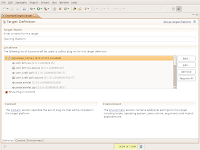What a milestone for
PDE.
Chris has been blogging away about things in M7, and I wanted to talk a little more about the target platform changes coming in M7.
When I started work on
PDE UI, this is all I knew about target platforms...

Talk about button overload. So many features, none of which I ever had touched as a debug plug-in developer. I didn't like the
UI, I was confused by the 'model' that backed it, and touching anything on that page seemed to break someone (or everyone).
Fortunately, in 3.5 the
PDE UI team: Chris A, Darin W, and myself along with
Ankur, Ben, Simon and other contributors, had the opportunity to make it better.

The fundamental change is that the preference page is no longer about crafting a target platform. It's about choosing the target you need. There are many new features available and there is a proper model (provisional
api as well) so interacting with targets
programmatically is much easier.
This was the first time I have written a significant
UI component in Eclipse. It has been quite the learning experience and I have even more respect for the platform
UI folks and those involved with the
p2 UI (which has developed into an excellent experience in 3.5). I
received a lot of feedback along the way and have made every effort to develop a
UI that respects legacy functionality, simplifies the story while supporting power users, and adds useful eye candy without button overload.
In the future expect even more information to come out about how to work with target platforms, talk about some new ideas we are considering, and posts about some cool features you may not notice at first glance (like
p2 provisioned targets). In the meantime, try out M7 and
let us know what you think!







